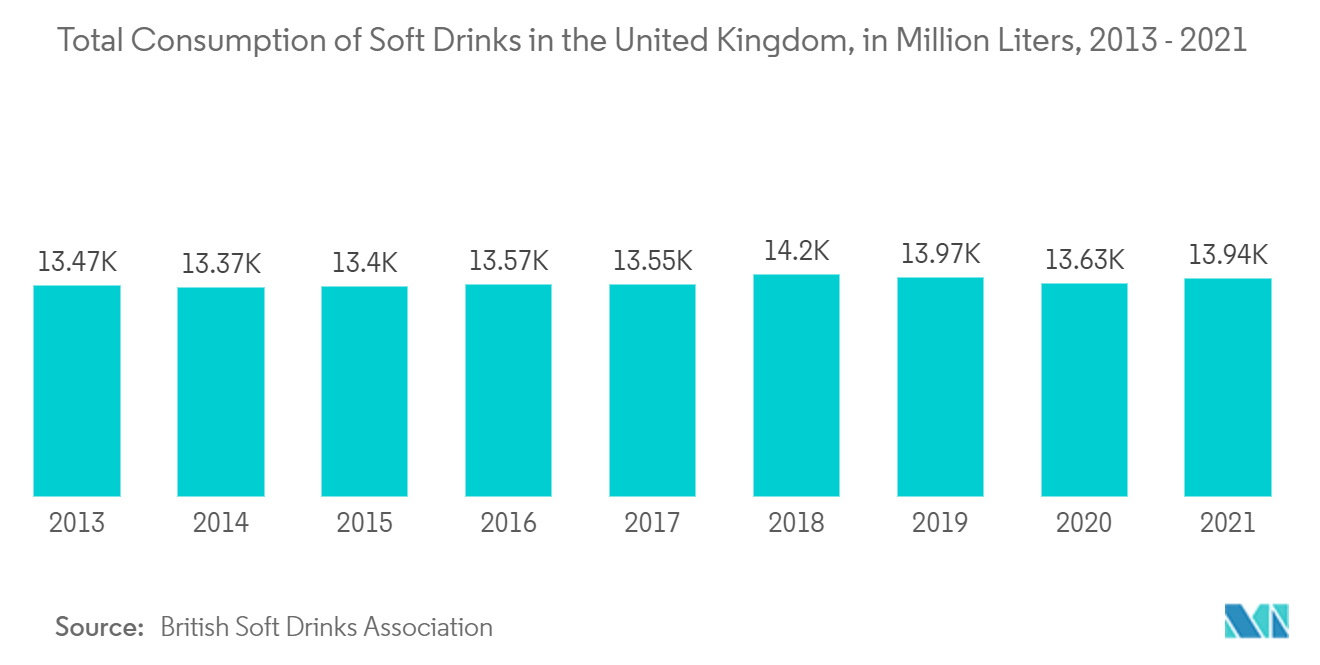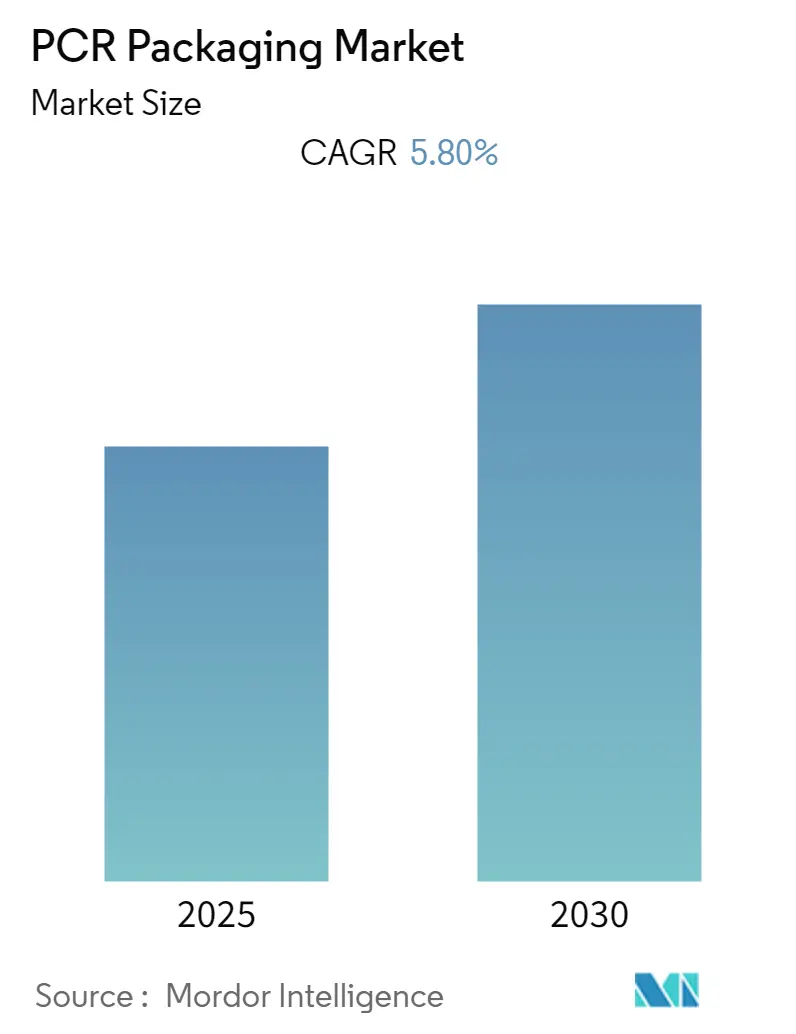
| Study Period | 2019 - 2030 |
| Base Year For Estimation | 2024 |
| Forecast Data Period | 2025 - 2030 |
| CAGR | 5.80 % |
| Fastest Growing Market | Asia-Pacific |
| Largest Market | Europe |
| Market Concentration | Low |
Major Players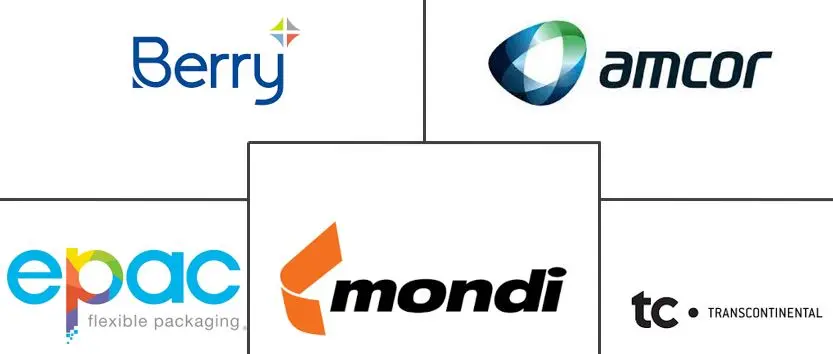
*Disclaimer: Major Players sorted in no particular order |
PCR Packaging Market Analysis
The PCR Packaging Market is expected to register a CAGR of 5.8% during the forecast period.
- PCR packaging is manufactured with a film made from recycled materials and cannot be recycled again since it is already made from recycled materials. This allows brands to fulfill their sustainability goals without relying on the consumer to recycle or compost the package after use. Such factors are propelling the market's growth.
- The growing demand for sustainable packaging and support from various global government initiatives are driving the market growth. For instance, in September 2020, the government in California signed a law that establishes recycled content for plastic beverage containers and requires a postconsumer plastic recycled content standard of 15% beginning January 1, 2022, increasing to 25% in 2025 and 50% in 2030.
- However, the lack of applicability of PCR packaging in certain applications owing to a risk of contamination or lack of consistency, such as pharmaceutical or medical applications, is likely to hamper the growth of the market.
- Several players in the industry are coming up with new product launches using post-consumer recycled resins. For instance, in February 2021, INDEVCO Plastics started offering PCR recycled packaging industrial solutions made from heavy-duty materials with up to 50% recycled resin content. The solution is available in form/fill/seal (FFS) films, centerfold films, and pre-formed bags. The company uses post-industrial recycled (PIR) or post-consumer recycled (PCR) resins and water-based, environmentally friendly inks to develop these new package options applicable for pet food and litter products, agricultural ingredients, building and industrial materials, and other heavy-duty uses.
- The supply chain disruption caused due to the unprecedented outbreak of Covid-19 affected production across the industries. During the pandemic, sales in the cosmetics industry, which accounts for a significant share of the market, have dropped. At the same time, the increasing sales of convenient foods, beverages, and pharmaceutical products are continuously adding growth to the market.
PCR Packaging Market Trends
Beverage Industry Driving the Growth
- PCR mandates are being implemented mandating certain percentage of PCR to be used in plastic packaging. For instance, to achieve the mandate of 30% post-consumer recycled (PCR) in California by 2030, the beverage companies are complying with the law by averaging high RPET content in their bottles sold in California, which includes BlueTriton Brands at 30%, CG Roxane (owner of Crystal Geyser brand water) at 50%, The Coca-Cola Company with 20%, and Pepsi Cola Bottling Group with 23% PCR.
- Prices of recycled plastic have doubled in the year 2021 owing to the increasing demand for soft drinks, and the focus of beverage manufacturers on achieving targets that resulted in an increase in the price of post-consumer polyethylene terephthalate (PET) in Europe.
- Moreover, to achieve the post-consumer recycled (PCR) target, the companies are focusing on recycling capacity expansion with investment. For instance, in September 2022, PepsiCo North America announced the investment of USD 35 million in the Closed Loop Local Recycling Fund launched by New York-based investment firm Closed Loop Partners in local recycling facilities to boost recycled PET (rPET) supply.
- The food industry accounted for significant PCR consumption in 2021 and is expected to create additional demand for PCR in packaging during the forecast period. Multiple FMCG brands have showcased 100% recycled PET beverage bottles as a visible commitment to cutting their environmental impact. For instance, in 2021, Coca-Cola North America rolled out 100% recycled PET plastic bottles for Coke, Diet Coke, Coke Zero Sugar, and Coca-Cola Flavors.
Europe Holds Significant Market Share
- The European Commission is considering an extension of mandatory recycled content targets to the sectors such as construction, automotive, and packaging, thereby increasing demand and stimulating the recycled plastics market. These measures would be in addition to the Commission's current requirements that polyethylene terephthalate (PET) beverage bottles contain at least 25% recycled PET (rPET) by 2025 and that all beverage bottles contain at least 30% recycled content by 2030.
- As a result, plastics producers and upstream recyclers are ramping up the production of PCR materials in response to strong market demand and legislative targets, while innovative brands are actively leveraging these materials in downstream products.
- According to PlasticsEurope, as the mandatory target of recycled content in packaging is 30% by 2030, its member has planned investments in chemical recycling technology and infrastructure, predicting Euro 2.6 billion by 2025 to Euro 7.2 billion by 2030 in Europe.
- In response to increasing demand for post-consumer recycled (PCR) packaging solutions the key players of packaging industry in the region are launching products according to EU and FDA compliance. For instance, in May 2022, flexible packaging manufacturer ProAmpac launched PCR retort pouch for pet and human food packaging. This pouch offers 30% or more PCR content by weight, reducing the use of virgin resins in the packaging. In addition, these pouches comply with the United Kingdom Plastics Packaging Tax.
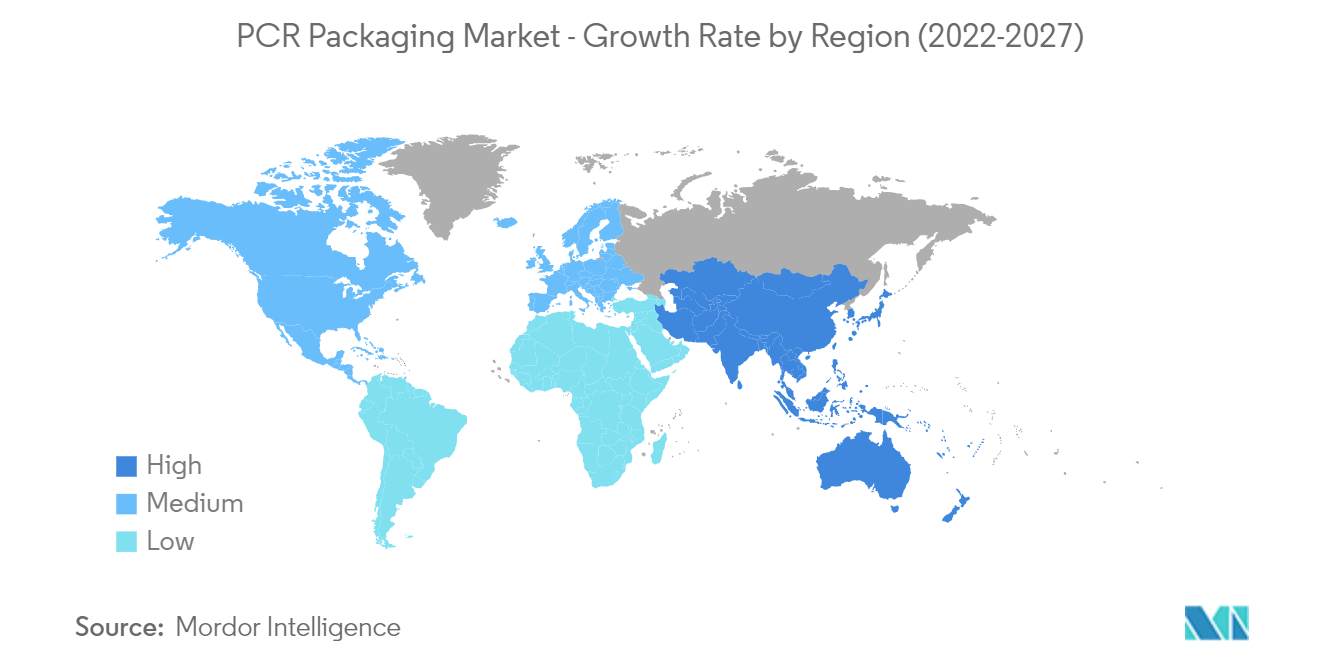
PCR Packaging Industry Overview
The PCR Packaging market is fragmented owing to a large number of players in the market. With the fierce competition, the players in the market are opting for various strategic initiatives to strengthen their position in the market. Some players are investing in product development and also forming partnerships and collaborations.
- July 2022 - The Design4Circularity initiative, which includes Clariant, Siegwerk, Borealis, and Beiersdorf, developed a colorless personal care bottle with 100% post-consumer recyclate (PCR) content, which features a printed deinkable full-body shrink sleeve for design differentiation. The collaboration between these personal care industry players aims to develop circular packaging solutions by accounting for each step of the development process. The initiative will create solutions that support plastic waste reduction, less use of virgin plastic material, and lower climate impact.
- May 2022 - Canada-headquartered paper products and packaging giant Cascades unveils 100% PCR packages and is selling a 100% RPET food tray. The recyclable tray has an innovative design that makes it compatible with packaging equipment already in use by food processors and retailers. The company said it has invested over USD 23 million into developing 100% RPET packaging.
PCR Packaging Market Leaders
-
Berry Global
-
Amcor plc
-
ePac Holdings, LLC
-
Mondi plc
-
Transcontinental Inc.
- *Disclaimer: Major Players sorted in no particular order
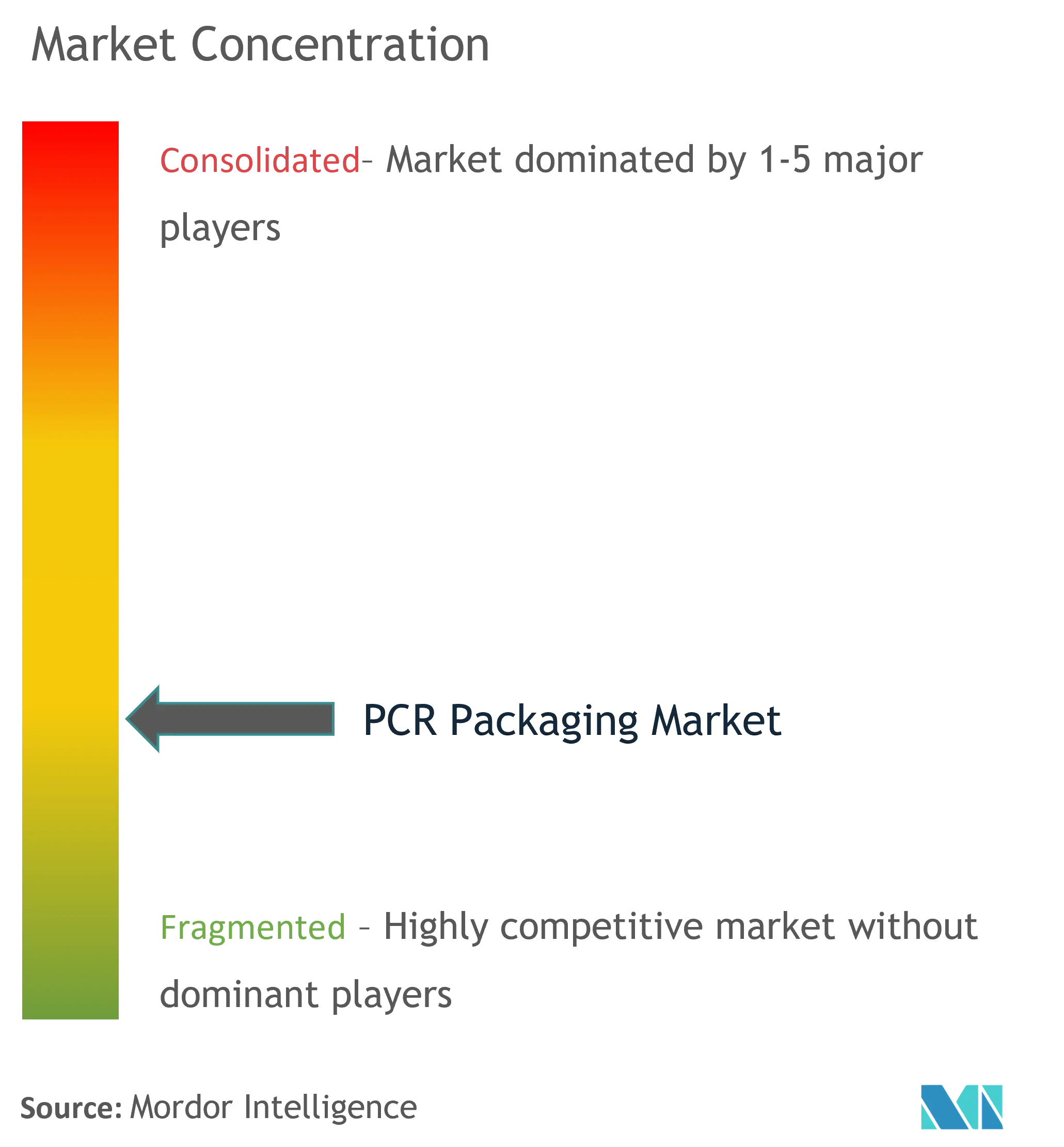
PCR Packaging Market News
- August 2022 - Mondi collaborated with Essity and Dow to create new, recyclable secondary packaging for Essity's feminine care products, using renewable materials and post-consumer recycled content that reduce fossil-based materials. Extensive research and testing by Mondi resulted in the recommendation of a new solution that aligns with Essity's packaging goals to work towards 100% recyclability and to use up to 85% biomass, renewable or recycled material in all bags where up to 25% are recycled plastics.
- July 2022 - Berry M&H announced several initiatives to support its customers' sustainability goals and help them meet the UK Plastic Packaging Tax requirements. Further, it stated that the majority of its standard products have now been tested and qualified to incorporate a minimum of 30% post-consumer recycled (PCR) plastic.
PCR Packaging Industry Segmentation
PCR Packaging refers to the packaging made of Post-Consumer Recycled material or Post-Consumer Resin such as PET, PP, and HDPE plastics which are recycled and then reprocessed into a resin that is used to make new packaging. The PCR Packaging Market is segmented By Material (PET, PE, PVC, PP, PS), Product (Bottles, Trays, Pouches), End User Vertical (Food, Beverage, Healthcare, Cosmetics, Industrial), and Geography
| By Material | PET |
| PE | |
| PVC | |
| PP | |
| PS | |
| Others | |
| By Product | Bottles |
| Trays | |
| Pouches | |
| Other Product Types | |
| By End-user Verticals | Food |
| Beverage | |
| Healthcare | |
| Cosmetics | |
| Industrial | |
| Other End user verticals | |
| By Geography | North America |
| Europe | |
| Asia Pacific | |
| Latin America | |
| Middle East and Africa |
PCR Packaging Market Research FAQs
What is the current PCR Packaging Market size?
The PCR Packaging Market is projected to register a CAGR of 5.8% during the forecast period (2025-2030)
Who are the key players in PCR Packaging Market?
Berry Global, Amcor plc, ePac Holdings, LLC, Mondi plc and Transcontinental Inc. are the major companies operating in the PCR Packaging Market.
Which is the fastest growing region in PCR Packaging Market?
Asia-Pacific is estimated to grow at the highest CAGR over the forecast period (2025-2030).
Which region has the biggest share in PCR Packaging Market?
In 2025, the Europe accounts for the largest market share in PCR Packaging Market.
What years does this PCR Packaging Market cover?
The report covers the PCR Packaging Market historical market size for years: 2019, 2020, 2021, 2022, 2023 and 2024. The report also forecasts the PCR Packaging Market size for years: 2025, 2026, 2027, 2028, 2029 and 2030.
Our Best Selling Reports
PCR Packaging Industry Report
Statistics for the 2025 PCR Packaging market share, size and revenue growth rate, created by Mordor Intelligence™ Industry Reports. PCR Packaging analysis includes a market forecast outlook for 2025 to 2030 and historical overview. Get a sample of this industry analysis as a free report PDF download.



